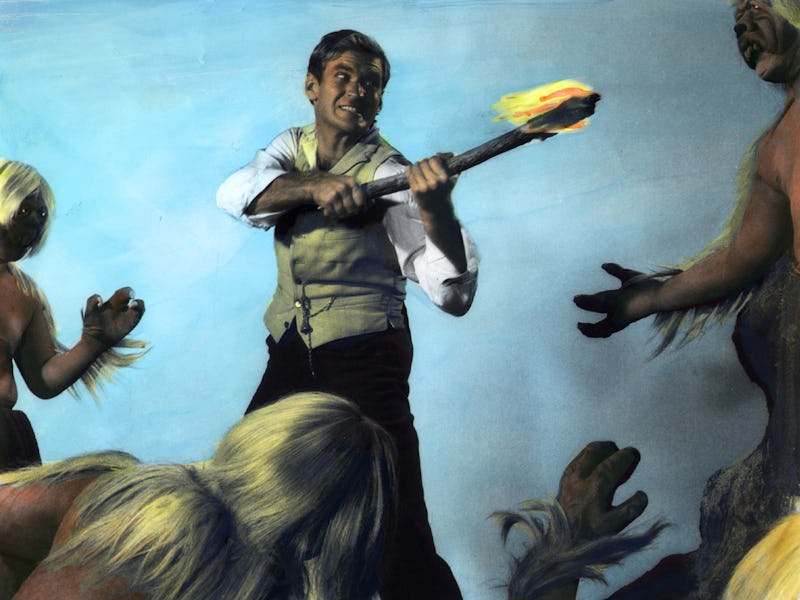Mandalorian Season 3's Descent Into Darkness Sneakily References A Sci-Fi Classic
What lies beneath Mandalore?

The Morlocks are back! As Din Djarin explores the dangerous surface of Mandalore, a planet once presumed cursed, he encounters enemies straight out of classic sci-fi, from a time long before Star Wars. Here’s how The Mandalorian Season 3, Episode 2, “The Mines of Mandalore,” tips its helmet to a style of science fiction monster from one of the oldest stories in the genre.
Spoilers ahead for “The Mines of Mandalore,” and The Time Machine.
In “The Mines of Mandalore,” the creatures that Mando fights off are more than a little reminiscent of the Morlocks in the 1960 film The Time Machine. Mando refers to these creatures as “Alamites,” but if you were time traveling from the ‘60s, you’d assume they were the new rulers of Mandalore. This resemblance didn’t go unnoticed by fans either, with several pointing out on Twitter that the Alamites look and act a lot like the Morlocks from The Time Machine.
An Alamite in The Mandalorian.
The Time Machine, of course, was a 1960 film based on the 1895 H.G. Wells novel of the same name. In it, an English time traveler from the Victorian age is propelled to the year 802,701. In this distant future, humankind has been split into two distinct classes: passive, tranquil people who live on the surface called the Eloi, and monsters called Morlocks, who dwell in the caverns below the surface. If you’ve never read the book or seen the 1960s movie (or the 2002 remake) here’s the big spoiler: The Eloi are not in control of the world, even though they seem to live better. Instead, we learn they are basically cattle bred and maintained by the Morlocks for food. The ultimate revelation of The Time Machine is that a seemingly utopian society has a cannibalistic and dystopian underbelly. In the 1960 film version, directed by George Pal, the Morlocks have an unforgettable appearance, which again, is more than a little reminiscent of Alamites in Mando.
So, what do Morlocks and The Time Machine have to do with The Mandalorian? Because Mando is not a time traveler and these creatures are not ruling the planet Mandalore, it seems like we could chalk up this visual similarity to an aesthetic homage and nothing more. And yet, the context of both “The Mines of Mandalore” and The Time Machine have a lot of similarities. Like Mandalore, the future-tense Earth in The Time Machine existed after a massive planet-wide cataclysm. The entire reason Mando is even on this planet is to see if it’s still livable at all, or if the radiation levels are too high. In The Time Machine, the Traveler (known as George in the movie, but who is unnamed in the book) travels into the future, eventually, to see what happened to the human race after several atomic wars. One question is the same in both quests: Is anybody left? What has happened to the planet?
Star Wars doesn’t technically take place in the future, but its futuristic tech does allow us to see aspects of the saga allegorically. While the debate will never end if Star Wars is true science fiction in spirit, it does use science fiction in its basic storytelling structure. Mando’s entire conflict in this episode is predicated upon a global event that changed Mandalore forever. And, as in The Time Machine, the Alamites seem to be a result of that massive planet-wide upheaval. Later in the episode, when Mando is captured by the strange cyborg insect, this too has shades of The Time Machine. Here again, is troglodyte, preying upon someone who lives on the surface.
The Morlocks in The Time Machine in 1960.
Mando’s goals are, of course, much different than that of the Traveler’s goals in The Time Machine. The overall purpose of The Mandalorian is also not in the same spirit as H.G. Well’s cautionary tale, either. And yet, Star Wars has always borrowed aesthetics from older sci-fi TV and film. Lucas was famously influenced by 1930s Flash Gordon, which informed the structure of A New Hope. But, Lucas pulled from other sci-fi sources, too. He openly admitted to having been inspired by Star Trek in the 1960s, and also, not-so-secretly borrowed words and specific themes from Dune. The point is, Lucas may not be in charge of Star Wars anymore, but the franchise does this all the time. Even if the Morlock homage is accidental, it also makes perfect sense.
Star Wars will always be a kind of blender for different sci-fi and fantasy motifs and aesthetics. Maybe some of these foundational monsters are always there, waiting to rise up from the surface and consume us with nostalgia, whether we remember them or not.
The Mandalorian is streaming on Disney+.
This article was originally published on